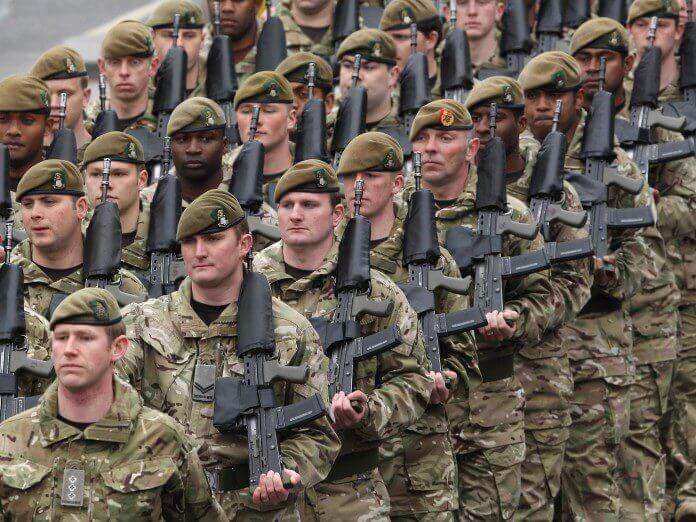In the British Army, ranks and symbols play a vital role in establishing the hierarchy and structure of the military organization.
These ranks and symbols signify the level of authority and responsibility held by everyone. Also, they reflect the rich history and traditions of the British Army.
The British Army is a part of the British Armed Forces, along with the Royal Navy and the Royal Air Force. It is the principal land warfare force of the UK, British Overseas Territories and Crown Dependencies.
The British Army has fought in major wars, including the Seven Years’ War, the Napoleonic Wars, the Crimean War, and WWI and WW2.
During the Cold War, the British Army was among the primary land force opposing the Soviet Union from 1946 – 1991.
The British Army’s victories in most of these decisive wars allowed the UK to influence world events. Thus, the UK is one of the world’s leading military and economic powers.
Since the end of the Cold War, the British Army has been deployed to several conflict zones. Deployment happened in the form of an expeditionary force, a coalition force or part of a peacekeeping operation.
Today, the British Army is a modern and professional force committed to protecting the UK’s national security & interests.
British Ranks and symbols are vital because they help to identify and differentiate between different levels of authority and responsibility. Also, they instill a sense of pride and loyalty among soldiers.
British Army Ranks
The British Army ranks consist of commissioned officers and non-commissioned officers. The British Army maintains a well-defined rank structure, where each position holds specific responsibilities, status, and logo. Therefore, observing a soldier’s uniform can help identify ranks.
British Army Commissioned Officers
Commissioned officers are the leaders of the British Army and are responsible for commanding troops and making strategic decisions. Here are the principal officer ranks in the British Army:
- Field Marshal: This is the highest rank in the British Army.
- General: Generals are senior officers responsible for commanding large military formations and overseeing operations.
- Lieutenant General: Lieutenant Generals hold high-ranking positions and are typically responsible for managing large military units.
- Major General: Major Generals are senior officers responsible for commanding divisions or brigades.
- Brigadier: Brigadiers are senior officers who command brigades, which are smaller military formations.
- Colonel: Colonels are senior officers who command regiments or serve in staff positions.
- Lieutenant Colonel: Lieutenant Colonels are mid-ranking officers who command battalions or serve in staff positions.
- Major: Majors are mid-ranking officers who command companies or serve in staff positions.
- Captain: Captains are junior officers who typically command sub-units within a company.
- Lieutenant: Lieutenants are junior officers who serve as platoon commanders or staff officers.
- Second Lieutenant: the most junior commissioned officers in the British Army
British Army Non-Commissioned Officers
Soldiers who have been promoted based on their skills, leadership abilities, and time in service. Here are the principal non-commissioned officer ranks in the British Army:
- Warrant Officer Class 1: Senior NCOs holding leadership positions and guiding officers and enlisted soldiers.
- Warrant Officer Class 2: Experienced NCOs with leadership positions and technical expertise.
- Sergeant Majors: Senior NCOs who serve as the commanding officer’s principal advisor on all matters relating to enlisted soldiers’ welfare, discipline, and morale.
- Staff Sergeant: Experienced NCOs who hold leadership positions and are responsible for the training and welfare of soldiers.
- Sergeant: Sergeants are NCOs who hold leadership positions and are responsible for supervising and training soldiers.
- Corporal: Corporals are junior NCOs who assist in supervising and training soldiers.
- Lance Corporal: the most junior NCO in the British Army.
- Private Soldier: rank after the trainee position.
British Army Ranks Symbols
In addition to the ranks, the British Army meticulously uses symbols to denote the different ranks. These symbols, precisely placed on the uniforms, aid in identifying the rank of each individual.
Here are some of the symbols used in the British Army:
- Pips: Pips are small, round symbols worn on officers’ epaulettes. The number of pips indicates the officer’s rank, with higher-ranking officers having more pips.
- Crowns: Officers and non-commissioned officers wear crowns to signify their rank. The number of crowns varies depending on rank, with higher-ranking individuals having more crowns.
- Stripes: Non-commissioned officers wear stripes on the sleeves to indicate their rank. The number and type of stripes vary depending on the rank.
- Wings: Pilots and aircrew wear wings to signify their qualification and rank within the Army Air Corps.
- Regimental Insignia: Each regiment in the British Army has its unique insignia worn on the uniform to signify membership in that regiment.
